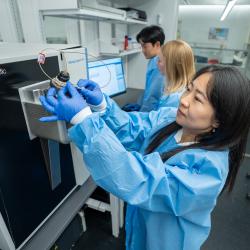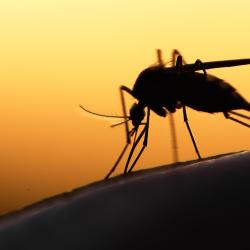Extreme Heat and Precipitation Are Increasing Salmonella Infections, UMD Study Shows
Coastal Communities Are Most Vulnerable
Extreme heat and precipitation events are associated with increased risk of salmonella infections, according to a new study by researchers from the University of Maryland and the Maryland Department of Health and Mental Hygiene. Severe weather events are expected to increase in frequency and intensity due to climate change, suggesting a connection between climate change and public health.
The study, published online June 18, 2015 in the journal Environment International, is also the first to provide evidence that salmonella infections related to extreme weather events disproportionately affect people living in the coastal areas of Maryland.
“We found that extremely hot days and periods of extreme rainfall are contributing to salmonella infections in Maryland, with the most dramatic impacts being seen in the coastal communities,” said Amir Sapkota, associate professor in the Maryland Institute for Applied Environmental Health at UMD and a co-author of the study. “As we prepare for the future, we need to take this differential burden into account”
Salmonella, a group of foodborne and waterborne bacteria, is commonly found in raw poultry, eggs and beef, and unwashed produce. Salmonella causes an estimated 1.2 million cases of acute gastroenteritis in the United States each year. Gastroenteritis is more commonly known as stomach flu, with symptoms including diarrhea, fever, vomiting and abdominal cramps.
In Maryland, more than 9,500 confirmed cases of salmonella infections were reported to the U.S. Centers for Disease Control and Prevention’s FoodNet program between 2002 and 2012. Past studies have suggested a connection between extreme weather events and Salmonella infections, also known as salmonellosis.
“We always worry about the vulnerability of coastal communities to sea level rise, coastal storms and harmful algal blooms,” said Raghu Murtugudde, UMD professor of atmospheric and oceanic science with an appointment at the Earth System Science Interdisciplinary Center and a co-author of the paper. “But this study shows a completely different aspect of natural-human system interactions in coastal regions. We need to keep an eye out for other potential vulnerabilities and find ways to enhance the resilience of these communities in the coming years.”
This new study identified extreme heat and precipitation events from 2002 to 2012 and linked them with the salmonella infection data from the FoodNet program. Extreme events were identified by comparing against nearly 30 years of weather data (1960-1989) as the baseline.
The research team observed that extreme heat and precipitation events were associated with 4.1 percent and 5.6 percent increases in the risk of salmonellosis, respectively. The observed risk was considerably higher in coastal areas compared with non-coastal areas of Maryland: 5.1 percent versus 1.5 percent for extreme heat events, and 7.1 percent versus 3.6 percent for extreme precipitation events.
The study highlights the need to engage public health practitioners and policymakers to prepare for and respond to climate change-associated adverse health effects at local, state and national levels.
###
This work was supported by the U. S. Centers for Disease Control and Prevention (Award Nos. 1UE1EH001049-01 and 5U01C1000310). The content of this article does not necessarily reflect the views of this organization.
The research paper, “Climate Change, Extreme Events and Increased Risk of Salmonellosis: Evidence for Coastal Vulnerability,” Chengsheng Jiang, Kristi Shaw, Crystal Upperman, David Blythe, Clifford Mitchell, Raghu Murtugudde, Amy Sapkota and Amir Sapkota, was published online June 18, 2015 in the journal Environment International.
Media Relations Contact: Kelly Blake, 301-405-9418, kellyb@umd.edu
University of Maryland
College of Computer, Mathematical, and Natural Sciences
2300 Symons Hall
College Park, MD 20742
www.cmns.umd.edu
@UMDscience
About the College of Computer, Mathematical, and Natural Sciences
The College of Computer, Mathematical, and Natural Sciences at the University of Maryland educates more than 7,000 future scientific leaders in its undergraduate and graduate programs each year. The college's 10 departments and more than a dozen interdisciplinary research centers foster scientific discovery with annual sponsored research funding exceeding $150 million.







